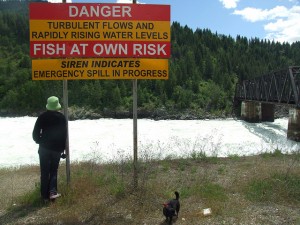Chapter 10. Risk Management and Legal Liability
10.1 Overview
This chapter examines the concepts of risk management and legal liability within the context of tourism and hospitality. We’ll review theoretical risk concepts and practical risk management applications while exploring applicable areas of statute, tort, and contract law. Insurance and occupational health and safety are also discussed. Examples from tourism and hospitality will be used throughout. Please note that the content provided in this chapter is provided for educational purposes, and should not be relied on in the event of legal action.
What is Risk Management?
Risk is defined as the potential for loss or harm (Destination Canada [publishing as CTC], 2003a). This could be experienced as a financial loss, damage to property, or injury to workers or guests. Understandably, tourism operators are interested in preventing these events from occuring, which is why practicing risk management is an essential business skill.

Risk management refers to the practices, policies, and procedures designed to minimize or eliminate unacceptable risks (Cloutier, 2000; Destination Canada [DC], 2003a; Heshka & Jackson, 2011). Depending on the type of operation undertaking the risk management process, these may vary greatly. Vastly different risks exist across the breadth of tourism and hospitality businesses; there are significant differences in the operation of a hotel as compared to delivering an adventure tourism activity. Consequently, it is helpful to think of risk management as being a process of determining the exposure to risk, and then initiating action to either minimize or eliminate the risk specific to your operation (Enterprise Risk Management, 2004). Mastering a generic model of risk management allows you to apply that model to all operations.
Why Practise Risk Management?
There are generally two core objectives in the practice of risk management by tourism operators: to avoid injury to guests and employees, and to protect their business operations from financial or physical ruin. Keeping guests and employees safe is a moral, ethical and legal responsibility; this is not to be taken lightly. Protecting business operations includes protecting against damage to property, damage to reputation, and any financial impacts occurring from litigation (Centre for Curriculum, Transfer, and Technology [CCTT], 2003a). By practising this twofold approach, operators demonstrate that they are prioritizing the health and safety of individuals, while still taking steps to protect the operational sustainability of their company.

On a larger scale, practising effective risk management can be seen as an important business skill. Destination Canada (2003a) suggests that risk management:
- Reduces the likelihood of an unwanted and unplanned event
- Reduces the consequences of the event
- Enhances your ability to access comprehensive and cost-effective insurance
Risk management can be undertaken at any scale. Individuals, companies, societies, communities, cities, regions, and even governments can follow the process in order to protect themselves from risks, which may range from company-specific risks associated with the operation or significant international risks such as climate change and civil disturbances.
Some risk management initiatives are more straightforward to implement than others; they are required by law and enforced by government agencies. For example, companies providing transportation services (such as commercial motor vehicle transport ) have clearly defined requirements as set out by their local motor vehicle branch in government. They are required to use appropriately licensed commercial drivers, submit to regularly scheduled commercial vehicle inspections, and insure their vehicles as required. Failing to adhere to these standards may result in suspension of operating privileges, fines, or even imprisonment. Similar to this is occupational health and safety; this is discussed later in the chapter.
However, other aspects of risk management are not regulated. This is characteristic of the majority of tourism and hospitality activities offered in Canada today. Operators offer services to the general public and self-regulate in terms of safety. If injury to a guest occurs, and that guest feels that he or she has grounds for a financial claim, that person can initiate a lawsuit against the tourism operator. If this claim is found valid in court, then the tourism operator may be responsible for a financial settlement to that claimant for damages – physical, financial or otherwise. To prevent, or to respond adequately to scenarios such as this, operations need to be both proactive and diligent in the practice of risk management.
In short, tour operators must comply with applicable statutory requirements and be sure to self-monitor to determine if the standard that they are operating at is acceptable to society and their peers. Failing to do so may result in a range of consequences including fines, suspension of operations, or a lawsuit.
Concepts of Risk
Before we proceed deeper into an examination of the risk management process, let’s look at three theoretical concepts of risk: real risk, perceived risk, and inherent risk.
Real risk is the actual statistical likelihood of an incident occurring. This is typically established through reviews of statistics and other relevant data, and by an analytical process and use of expertise in the field. There is little ambiguity or subjectivity in real risk (DC, 2003a).
Perceived risk is the perception of risk by those undertaking or evaluating the risk itself; it may vary greatly based on their level of apprehension, anxiety, or experience with the specific risk. Perceived risk can also vary greatly from the real risk of an activity; it can be higher or lower than the actual risk. In Adventure Tourism, successful management of perceived risk may include operators promoting the risk of activity as high, even if in reality the risk is minimal (Dowling, 1986).
Inherent risk is the risk that must exist for the activity to occur; examples include the risk of drowning whilst swimming and the risk of falling during skiing. It is impossible to eliminate inherent risk from these activities because it would preclude participating in them. However, operators should take steps to minimize inherent risk; this could include, for example, conducting safety inspections, providing appropriate safety equipment for guests, training staff, and informing participants of the hazards of the activity (CCTC, 2003b).

Image Credits
Figure 10.1 Turbulent Flows by Curtis Perry is used under a CC BY-NC-ND 2.0 license.
Figure 10.2 Larry O’Brien Verdict press core-0219 by David Carroll is used under a CC BY 2.0 license.
Figure 10.3 Not a good thing to move from a hotel room to a hospital room by Canadian Pacific is used under a CC BY-NC 2.0 license.
The possibility for loss or harm.
Practices, policies, and procedures designed to minimize or eliminate unacceptable risks.
The actual risk of the practice, activity, or event; generally determined by statistical evidence.
The perception of the risk level of the practice, activity, or event; varies greatly from person to person.
Risk that is inherent to the activity and that cannot be removed.

